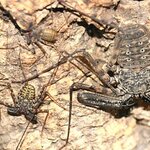Ecology & Zoology

Maps of the sea surface temperature around Galapagos Islands and Cocos Island in the Pacific Ocean are being produced daily and are available online in full resolution in near-real time as part of the Medspiration project, an ESA-funded effort to represent the most reliable temperature of the seas on a global basis.
Galapagos Islands and Cocos Island have been integrated into Medspiration until 31 March in order to support the study of wildlife migration processes from the two islands as part of ESA’s new Diversity project, which kicked off in January 2007 to support the initiative of the…

Over a span of two decades, warming temperatures have caused annual losses of roughly $5 billion for major food crops, according to a new study by researchers at the Carnegie Institution and Lawrence Livermore National Laboratory.
From 1981-2002, warming reduced the combined production of wheat, corn, and barley—cereal grains that form the foundation of much of the world’s diet—by 40 million metric tons per year. The study, which will be published March 16 in the online journal Environmental Research Letters, demonstrates that this decline is due to human-caused increases in global…

Video evidence that an extinct woodpecker is alive and well in Arkansas, USA may prove to be a case of mistaken identity. Research published today in the open access journal BMC Biology shows how fleeting images thought to be the Ivory-billed Woodpecker Campephilus principalis could be another native woodpecker species.
J. Martin Collinson compared David Luneau's Arkansas video footage from April 2004 of the supposed Ivory-billed Woodpecker with fresh footage of the Pileated Woodpecker Dryocopus pileatus, a superficially similar black and white species. The Pileated Woodpecker's wings were…

It has long been recognized that birds possess the ability to use the Earth’s magnetic field for their navigation, although just how this is done has not yet been clarified. However, the discovery of iron-containing structures in the beaks of homing pigeons in a new study (1) by Gerta Fleissner and her colleagues at the University of Frankfurt offers a promising insight into this complex topic. The article will be published online mid-March in Springer’s journal Naturwissenschaften.
In histological and physicochemical examinations in collaboration with HASYLAB, the synchrotron laboratories…

A team of UBC researchers has re-classified an ancient line of aquatic plants previously thought to be related to grasses and rushes. The discovery clarifies what may be one of the biggest misunderstandings in botanical history.
"It’s a classic case of mistaken identity," says Sean Graham, an associate professor and researcher with the UBC Botanical Garden and Centre for Plant Research in the Faculty of Land and Food Systems. "And it took DNA sequence evidence coupled with a critical re-examination of anatomy to assign these plants to their proper place in the plant evolutionary family tree…

Whip spiders, considered by many to be creepy-crawly, are giving new meaning to the term touchy-feely.
In two species of whip spiders, or amblypygids, mothers caress their young with long feelers, siblings stick together until they reach sexual maturity, and all mix in social groups. This is surprising behavior for these arachnids long-thought to be purely aggressive and anti-social, according to a Cornell researcher.
A mother amblypygid with several of her 7-month-old offspring. Their whips are touching one another.
Social behavior is extremely rare in arachnids, a class that includes…

Two Iowa State University botanists and their colleague at the University of North Carolina have discovered a new species of North American bamboo in the hills of Appalachia. It is the third known native species of the hardy grass. The other two were discovered more than 200 years ago.
Lynn Clark, Iowa State professor of ecology, evolution and organismal biology, and Ph.D. student Jimmy Triplett study bamboo diversity and evolution. They first heard about "hill cane" from Alan Weakley, a botanist at the University of North Carolina. Although the plant was known to the people in the area, its…

Plant and animal diseases can play a major and poorly appreciated role in allowing the invasion of exotic species, which in turn often threatens biodiversity, ecological function and the world economy, researchers say in a new report.
In particular, a plant pathogen appears to have opened the gate for the successful invasion of non-native grasses into much of California, one of the world's largest documented cases of invading species and one that dramatically changed the history and ecology of a vast grassland ecosystem.
Global air network showing hotspots for invasion of foreign species.…

Genetically modified crops were supposed to improve efficiency and make life easier for farmers in poor countries. The opposite may be true, according to a Washington University in St. Louis study. Technology may be racing too fast for farmers to keep up. It may even be linked to higher suicide rates.
The arrival of genetically modified crops has added another level of complexity to farming in the developing world, says a sociocultural anthropologist at Washington University in St. Louis.
Glenn D. Stone, Ph.D., professor of anthropology and of environmental studies, both in Arts &…
Soprano syndrome in the mousehouse?
One of the first things my mice did when introduced to their new Chinese-made home (details on that to come later) was to seek out their new boundaries. Then, almost as a herd, they sought out the little clear red mouse house in the center of the cage. Boundary, then home. I note this same basic instinct in the ethology of the three categories of mammals I observe the most: my nephews, my horse, and, now, my four black6 lab mice.
My nephews are constantly pushing their boundaries--precisely because they want something to push back and thus…